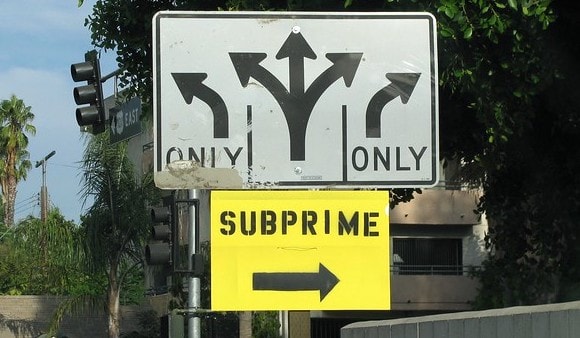
When the notion of non-QM first surfaced, many critics were quick to point out that it was the return of subprime lending.
At first glance, the argument carries some weight because the Qualified Mortgage rule was born out of the Great Recession, which was mostly caused by the massive housing collapse tied to subprime mortgages.
In short, mortgage lenders in the early 2000s basically gave up on sound underwriting because the underlying home loans were sliced and diced and sold on Wall Street. It was a game of hot potato.
This hasn’t really been debated – the quality of mortgage loans in 2005-2006 and surrounding years were abominable.
Most banks relied on stated income or no documentation at all. A credit score was pretty all you needed. And it didn’t even need to be a good one.
Fast forward to today and it’s quite a bit different, even if mortgage lenders are originating loans outside the QM box.
What is a Subprime Mortgage?
By definition, it’s a home loan that isn’t prime, aka not vanilla or of the highest quality.
In practice, a mortgage is/was typically deemed subprime if it’s FICO score fell below 620.
For example, a borrower with a 619 FICO score would be considered a subprime borrower, even if they fully documented their income and put down 35% on a home purchase. Even if they had $1 million in the bank and a 20% DTI ratio.
Meanwhile, a loan could be considered near-prime or even prime with a slightly higher credit score, yet still be no doc, or 100% CLTV, or any combination of typical risk factors.
It could even be a neg-am and considered prime!
Ultimately, credit score carries a lot of weight when it comes to the definition, at least in the mortgage world, but it’s probably not the best indicator of default, at least not on its own.
As we later found out, scores of homeowners stopped paying their mortgages because their properties were worth less than what they purchased them for (underwater mortgages).
There’s a good chance that many of these borrowers had FICO scores well above 620. Were their loans actually subprime?
Maybe not by the credit score definition, but in the eyes of just about everyone, YES!
Why? Because they likely overstated their income, borrowed more than they could afford, pulled out cash from their home to buy fancy cars and other extravagant items, and then walked away when it all came tumbling down.
Their 100% LTV ratio may have also had something to do with that.
How Non-QM Differs from Subprime
Today, things are a lot different. While non-QM lenders can still originate loans that may share qualities with past subprime mortgages, the game is not the same.
For one, non-QM lenders still have to abide by the Ability-to-Repay (ATR) rule and its eight underwriting factors in most cases.
Those include things like documenting income or assets, qualifying at fully-indexed interest rates, considering outstanding debt, and credit history.
An exception is business purpose loans such as DSCR loans, which qualify the borrower based on the income the property generates.
Anyway, the big advantage for QM lenders is that there is a presumption of compliance with the ATR rule, whereas non-QM lenders don’t enjoy such assurances.
That’s bring us to the second big point – liquidity for non-QM loans is nowhere near what it was for subprime mortgages back in 2006.
Sure, that’s beginning to change and there are whispers about Wall St. once again eating it up, just like they did subprime.
But they aren’t buying mortgage securities backed by 4-unit non-owner occupied properties set at 100% CLTV with 600 FICO scores.
They’re buying stuff that falls outside the QM rule for one reason or another, which in all likelihood has still been underwritten according to the ATR rule.
And in a lot of cases, the credit scores are probably high, the LTVs low, and the layered risk night and day compared to what we saw over a decade ago.
Can a non-QM loan default? Sure. Just like a subprime loan. But that doesn’t make them the same.
So while some want to use non-QM and subprime interchangeably, it’s simply not accurate or fair to do so.